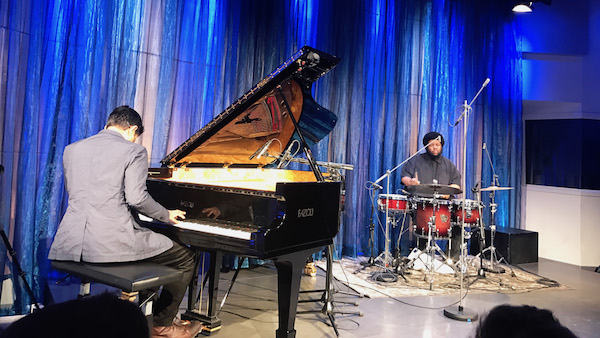Dec 9, 2025 12:28 PM
In Memoriam: Gordon Goodwin, 1954–2025
Gordon Goodwin, an award-winning saxophonist, pianist, bandleader, composer and arranger, died Dec. 8 in Los Angeles.…

Vijay Iyer (left) and Tyshawn Sorey at Q2 in New York on April 13.
(Photo: Chris Tart)Q2 Music, a multi-platform home for musical discovery dedicated mostly to modern classical composition, hosted a program called Vijay Iyer & Friends on April 13, an event that saw the titular pianist, drummer Tyshawn Sorey, reedist Rudresh Mahanthappa, violinist Jennifer Koh and composer George Lewis congregate for a night of music and discussion.
The evening played out like a live podcast recording, foreshadowing the upcoming Ojai Festival in California where Iyer is serving as music director for the 2017 edition. The program was streamed live on Facebook, and viewers can access the entire 101-minute program here.
Beginning with a solo piano work entitled “Otoscopy,” a piece that dances around the idea of the out-of-body experience, Iyer oscillated between free play and form. At times chaotic, at times melodic, the tune eventually spiraled into something tangible and beautiful, so much so that a gentleman in the front row was called up onto the stage to discuss what he felt during the playing. Iyer would later admit that he’s had a number of out-of-body experiences over the course of his life, usually triggered by music.
While playing the second part of this piece, Iyer delivered a central melody with his right hand and alternated bass notes and treble notes with his left hand. He attributed the influence of this unorthodox style of playing to Thelonious Monk, citing a 1966 video of Monk performing “Lulu’s Back In Town” that Lewis—who was seated in the front row—brought to Iyer’s attention. Iyer has never been shy to discuss Monk’s immense influence on his playing; however it was still a treat to hear Iyer discover new subtleties in Monk’s work.
Drummer Tyshawn Sorey joined Iyer for the next piece, on which Iyer wove threads of avant-garde composition into a hip-hop tapestry (a recurring trope for the pianist). Iyer and Sorey, who share a long history together, have an uncanny ability to bring high-brow composition—avant-garde, classical, free-jazz—into more accessible context. This is exactly what happened during the nine-minute duet. The two will dig further into their musical chemistry with a run of shows at The Village Vanguard from May 9–14.
Sorey and Iyer will also perform together at California’s Ojai Music Festival. Last year at the fest, Sorey debuted Josephine Baker: A Portrait. This year, he’ll assume the role of drummer in Iyer’s Trio, as well as conductor for the chamber piece Autoschediasms For Creative Chamber Orchestra. The four-day program is the common thread between the performers at Q2, who all play with Iyer, with the exception of Koh.
Koh and Iyer, while they didn’t perform together for us on this night, do have a collaborative work in the making. Iyer has just finished writing a concerto for the violin marvel. That work isn’t quite ready, but Koh’s thrashing, experimental performance gave us a taste of what we could maybe expect from these two boundary-pushers.
For the final performance, saxophonist/composer Mahanthappa joined Iyer on the stage. Mahanthappa was filling in for Wadada Leo Smith, who was originally on the bill to play a duet with Iyer, reprising their roles from last year’s acclaimed album A Cosmic Rhythm With Each Stroke (ECM).
As a musical dialog partner, Mahanthappa made for a great chat. They went on to play two seamless pieces: Iyer’s “React” followed by Mahanthappa’s “Hope.” It combined for about 20 minutes of music in which the harmonious bond between the two progressive South Asian artists was on full display. Even in an intimate duo setting, they’re capable of producing great swaths of sound, tension and emotion.
Trombonist/composer Lewis, who didn’t perform at the event but did take part in discussion, said, “I still like to go on stage when it’s the very coolest people [performing].” This is a good summary for an evening that hosted a Harvard professor (Iyer), a gentleman who’s about to receive a doctorate degree at Columbia (Sorey), that gentleman’s professor (Lewis), someone who holds a Master of Fine Arts degree from DePaul University (Mahanthappa), multiple Macarthur Fellows and more.
Hearing these musicians play and share their philosophy was more than just a treat: it was a collegiate-level crash-course in the modern world of musical improvisation in which the professors played some blazing tunes. DB

Goodwin was one of the most acclaimed, successful and influential jazz musicians of his generation.
Dec 9, 2025 12:28 PM
Gordon Goodwin, an award-winning saxophonist, pianist, bandleader, composer and arranger, died Dec. 8 in Los Angeles.…

Flea has returned to his first instrument — the trumpet — and assembled a dream band of jazz musicians to record a new album.
Dec 2, 2025 2:01 AM
After a nearly five-decade career as one of his generation’s defining rock bassists, Flea has returned to his first…

Belá Fleck during an interview with Fredrika Whitfield on CNN.
Jan 13, 2026 2:09 PM
The fallout from the renaming of the John F. Kennedy Center for the Performing Arts to include President Donald…

“It’s a pleasure and an honor to interpret the music of Oscar Peterson in his native city,” said Jim Doxas in regard to celebrating the Canadian legend. “He traveled the world, but never forgot Montreal.”
Nov 18, 2025 12:16 PM
In the pantheon of jazz luminaries, few shine as brightly, or swing as hard, as Oscar Peterson. A century ago, a…

Dec 11, 2025 11:00 AM
DownBeat presents a complete list of the 4-, 4½- and 5-star albums from 2025 in one convenient package. It’s a great…